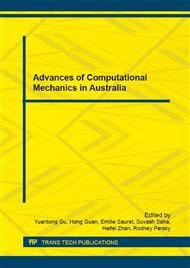[1]
Zienkiewicz OC, and Shiomi T. Dynamic behaviour of saturated porous media; The generalized Biot formulation and its numerical solution. Int. J. Numer. Anal. Meth. Geomech. 1984; 8: 71–96.
DOI: 10.1002/nag.1610080106
Google Scholar
[2]
Zienkiewicz OC, Xie YM, Schrefler BA, Ledesma A, Biĉaniĉ N. Static and dynamic behaviour of soils: A rational approach to quantitative solutions. II. Semi-saturated problems. Proc. R. Soc. Lond. A 1990; 429: 311-321.
DOI: 10.1098/rspa.1990.0062
Google Scholar
[3]
Meroi EA, Schrefler BA, Zienkiewicz OC. Large strain static and dynamic semisaturated soil behaviour. Int. J. Numer. Anal. Meth. Geomech. 1995; 19: 81-106.
DOI: 10.1002/nag.1610190203
Google Scholar
[4]
Schrefler BA, Scotta R. A fully coupled dynamic model for two-phase fluid flow in deformable porous media. Computer Methods in Applied Mechanics and Engineering 2001; 190: 3223–3246.
DOI: 10.1016/s0045-7825(00)00390-x
Google Scholar
[5]
Shahbodagh Khan B. Large deformation dynamic analysis method for partially saturated elasto-viscoplastic soils, PhD dissertation, Kyoto University, (2011).
Google Scholar
[6]
Khoei AR, Mohammadnejad T. Numerical modeling of multiphase fluid flow in deforming porous media: A comparison between two- and three-phase models for seismic analysis of earth and rockfill dams. Computers and Geotechnics, 38(2), 2011: 142-166.
DOI: 10.1016/j.compgeo.2010.10.010
Google Scholar
[7]
Uzuoka R, Borja RI. Dynamics of unsaturated poroelastic solids at finite strain. International Journal for Numerical and Analytical Methods in Geomechanics 2012; 36: 1535-1573.
DOI: 10.1002/nag.1061
Google Scholar
[8]
Ravichandran N, Muraleetharan KK. Dynamics of unsaturated soils using various finite element formulations. International Journal for Numerical and Analytical Methods in Geomechanics 2009; 33: 611–631.
DOI: 10.1002/nag.737
Google Scholar
[9]
Prevost JH. Nonlinear transient phenomena in saturated porous media, Computer Methods in Applied Mechanics and Engineering 1982; 30(1): 3-18.
DOI: 10.1016/0045-7825(82)90052-4
Google Scholar
[10]
Simon, B. R., Wu, J. S., Zienkiewicz, O. C., & Paul, D. K. (1986).
Google Scholar
[11]
Zienkiewicz OC, Chang CT, Bettess P. Drained undrained consolidating and dynamic behaviour assumptions in soils. Geotechnique 1980; 30(4): 385-395.
DOI: 10.1680/geot.1980.30.4.385
Google Scholar
[12]
Khalili N, Habte MA, Zargarbashi S, A fully coupled flow deformation model for cyclic analysis of unsaturated soils including hydraulic and mechanical hystereses, Computers and Geotechnics 2008; 35(6): 872-889.
DOI: 10.1016/j.compgeo.2008.08.003
Google Scholar
[13]
Bishop, A.W. 1959. The principle of effective stress. Teknisk Ukeblad; 106(39): 859–863.
Google Scholar
[14]
Khalili N, and Khabbaz MH. A unique relationship for shear strength determination of unsaturated soils, Geotechnique 1998; 48(5): 681-688.
DOI: 10.1680/geot.1998.48.5.681
Google Scholar
[15]
Khalili N., Geiser F, Blight G. Effective stress in unsaturated soils: Review with new evidence. International Journal of Geomechanics 2004; 4(2): 115–126.
DOI: 10.1061/(asce)1532-3641(2004)4:2(115)
Google Scholar
[16]
Brooks RH, Corey AT. Hydraulic properties of porous media: Hydrology Papers. Colorado State University, Colorado, (1964).
Google Scholar
[17]
van Genuchten MT. A closed-form equation for predicting the hydraulic conductivity of unsaturated soils. Soil Science Society of America Journal 1980; 44(5): 892-898.
DOI: 10.2136/sssaj1980.03615995004400050002x
Google Scholar
[18]
Shahbodagh Khan B, Khalili N, Esgandani GA. A numerical model for nonlinear large deformation dynamic analysis of unsaturated porous media including hydraulic hysteresis. Computers and Geotechnics 2015; 69: 411-423.
DOI: 10.1016/j.compgeo.2015.06.008
Google Scholar
[19]
Khoshghalb A, Khalili N. A meshfree method for fully coupled analysis of flow and deformation in unsaturated porous media, Int. J. Numer. Anal. Meth. Geomech. 2013; 37(7): 716 - 743.
DOI: 10.1002/nag.1120
Google Scholar
[20]
Oka F, Kimoto S. Computational modeling of multiphase geomaterials. CRC press, Taylor & Francis group, Boca Raton, London and New York, (2012).
Google Scholar
[21]
Kimoto S, Shahbodagh Khan B, Mirjalili M, Oka F. A cyclic elasto-viscoplastic constitutive model for clay considering the nonlinear kinematic hardening rules and the structural degradation, International Journal of Geomechanics 2013; A4014005.
DOI: 10.1061/(asce)gm.1943-5622.0000327
Google Scholar
[22]
Shahbodagh Khan, B., Mirjalili, M., Kimoto, S. and Oka, F. 2013. Dynamic analysis of strain localization in water-saturated clay using a cyclic elasto-viscoplastic model, International Journal for Numerical and Analytical Methods in Geomechanics 2014; 38(8), 771-793.
DOI: 10.1002/nag.2221
Google Scholar
[23]
Simon BR, Zienkiewicz OC, Paul DK. An analytical solution for the transient response of saturated porous elastic solids. Int. J. Numer. Anal. Meth. Geomech. 1984; 8: 381-398.
DOI: 10.1002/nag.1610080406
Google Scholar


